Table 1.
Posture and weight-bearing.
a. Non-physiologic Locomotion
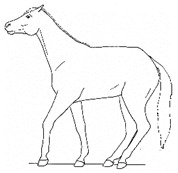
|
Lameness, including altered stride, impact, and weight-bearing. May include altered limb placement, head, and neck movements that suggest off-loading, and/or limited range of motion of a limb. Video S2 https://doi.org/10.5281/zenodo.4537915 (accessed on 18 February 2021) |
b. Shifting Weight/Resting Limb
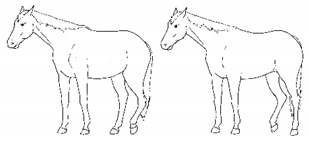
|
Frequent shifting of the primary weight-bearing limb or limbs. The frequency of abnormal weight shifting is typically greater during the transition to standing rest, as if the horse is having difficulty finding a comfortable resting position. Video S3 https://doi.org/10.5281/zenodo.4537972 (accessed on 18 February 2021) |
c. Pointing
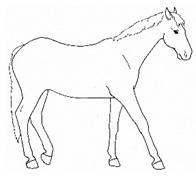
|
Consistent extension of one forelimb, reducing weight-bearing on that limb. Pointing is often most apparent during periods of standing rest, but can also occur during foraging, when one forelimb is consistently placed cranially, while the other is placed caudally and under the body (healthy comfortable horses typically either stand squarely on forelimbs or alternate forelimb placement as they move while foraging). Video S4 https://doi.org/10.5281/zenodo.4537978 (accessed on 18 February 2021) |
d. Prolonged Resting of Limb
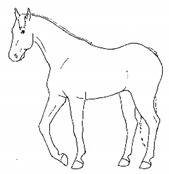
|
Flexing a fore or hindlimb, resting the toe of the hoof on the substrate. Hindlimb resting is a normal behavior, particularly during standing rest. Prolonged resting of a particular limb, especially when standing alert or foraging, may indicate discomfort. Video S5 https://doi.org/10.5281/zenodo.4538011 (accessed on 18 February 2021) |
e. Cross-legged Resting of Limb

|
Resting a limb (usually hind) crossed slightly behind or in front of the opposite limb. Video S6 https://doi.org/10.5281/zenodo.4538028 (accessed on 18 February 2021) |
f. Camping Under
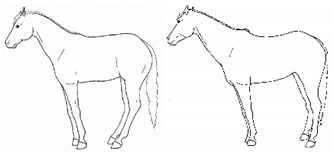
|
Standing with fore and/or hindlimbs bilaterally positioned underneath the abdomen, sometimes associated with a hunched back posture. Weight-bearing is greater on the camped under limbs or, in the case of camping under on both fore and hindlimbs, may be associated with relieving weight-bearing of the back. Video S7 https://doi.org/10.5281/zenodo.4538039 (accessed on 18 February 2021) |
g. Dragging a Limb
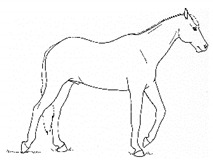
|
Partially flexing a limb such that the toe scrapes along or slightly above the substrate when moving. Video S8 https://doi.org/10.5281/zenodo.4539062 (accessed on 18 February 2021) |
h. Dangling a Limb
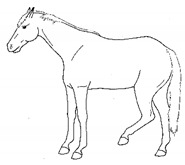
|
Flexing and hanging a limb above the substrate for several seconds or longer, often in a series, momentarily resting the tow lightly on the substrate between lifts. Video S9 https://doi.org/10.5281/zenodo.4538101 (accessed on 18 February 2021) |
i. Base Narrow or Wide
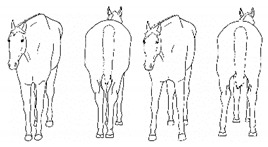
|
Standing or moving with fore and/or hindlimbs placed either more medially or laterally than is normal for the horse’s conformation. Video S10 https://doi.org/10.5281/zenodo.4538117 (accessed on 18 February 2021) |
j. Low Head Carriage
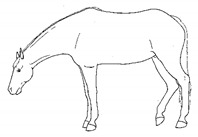
|
Moving or standing with the neck below horizontal. In deep standing rest, it is normal for the head and neck to drop below horizontal. Low head carriage is often associated with dull overall demeanor or exhaustion. Video S11 https://doi.org/10.5281/zenodo.4538125 (accessed on 18 February 2021) |
k. Tucked Up Abdomen
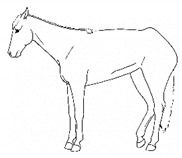
|
Tensing of the abdominal muscles, hollowing out the flank, sometimes with a hunched back. Reduced ingesta and dehydration may contribute to the hollow appearance (also known as “drawn up” or “sucked up”). Video S12 https://doi.org/10.5281/zenodo.4538135 (accessed on 18 February 2021) |
l. Leaning Against Objects
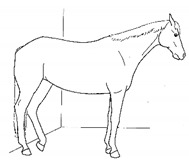
|
Supporting weight and/or stabilizing balance against a wall or fence, usually during standing rest. Video S13 https://doi.org/10.5281/zenodo.4539088 (accessed on 18 February 2021) |
m. Atypical Recumbency
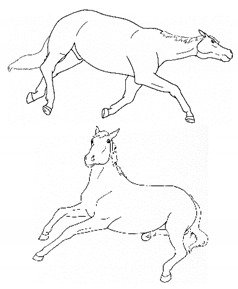
|
Prolonged or frequent interrupted recumbent rests and/or increased recumbent resting time budget. Atypical recumbency may occur during circumstances when the horse would not normally lie down, and the horse may lie in full lateral recumbency without sleeping. Atypical recumbency may include sighing and/or groaning, tense facial muscles, gaping mouth, lip quivering/wincing, teeth grinding, and/or atypical limb placement. For healthy horses, typical individual recumbency durations range from 15 to 40 min. Prolonged recumbency may be related to difficulty rising, discomfort standing, or exhaustion. Videos S14 and S15 https://doi.org/10.5281/zenodo.4539094 (accessed on 18 February 2021) |
n. Difficulty Rising
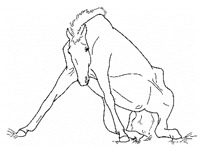
|
Failing to rise gracefully, requiring increased effort and/or attempts to rise. Video S16 https://doi.org/10.5281/zenodo.4539120 (accessed on 18 February 2021) |
o. Urination Posture and Effort Without Stream
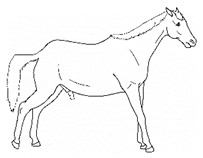
|
Posturing to urinate, often repeatedly for extended durations, with apparent effort, but without a normal stream of urine. Often accompanied by groaning, swishing, or slapping tail, ears focused caudally, looking caudally, and/or kicking up toward abdomen. Video S17 https://doi.org/10.5281/zenodo.4539122 (accessed on 18 February 2021) |
p. Parking Out
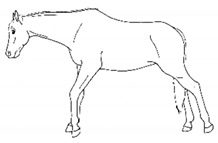
|
Standing with forelimbs positioned forward and hindlimbs positioned behind a normal “squared up” stance. Video S18 and Photo S19 https://doi.org/10.5281/zenodo.4539206 (accessed on 18 February 2021) |
q. Straining to Defecate
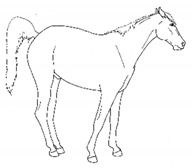
|
Exerting greater than the normal abdominal effort to pass feces. Often accompanied by groaning, swishing/flicking tail, slapping tail against perineum, ears focused caudally, looking caudally, and/or kicking up toward abdomen. Video S20 https://doi.org/10.5281/zenodo.4539216 (accessed on 18 February 2021) |
